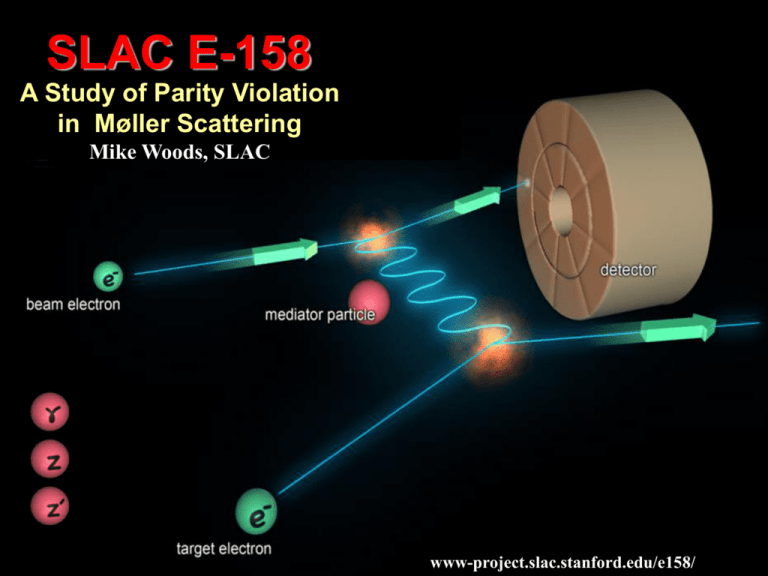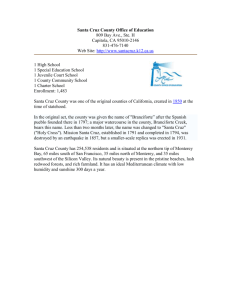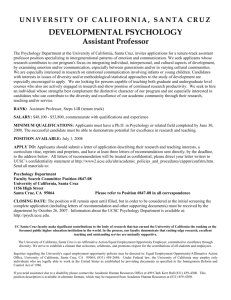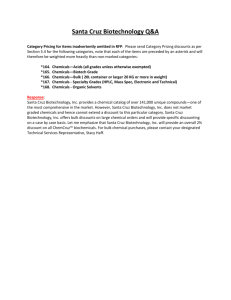E - SLAC Project
advertisement

SLAC E-158
A Study of Parity Violation
in Møller Scattering
Mike Woods, SLAC
UC Santa Cruz 10-25-05
www-project.slac.stanford.edu/e158/
1
M. Woods (SLAC
E-158)
Outline
•
•
•
•
•
•
Physics Motivation
E158 Beam and Beam Monitors
LH2Target and Spectrometer
Detectors
Analysis
Results & Outlook
UC Santa Cruz 10-25-05
M. Woods (SLAC E-158)
2
Beyond the Standard Model
Energy Frontier
• Tevatron
• LHC
• (Linear Collider)
Symmetry Violations
Rare or Forbidden Processes
Precision Electroweak Measurements
Indirect access to TeV-scale physics
Can clarify gauge structure and nature of
New Physics discoveries at colliders
Can motivate parameters for new colliders
(ex. ILC, LHC upgrades, VLHC)
Current Low Energy experiments can probe New Physics at (1 – 10) TeV!
UC Santa Cruz 10-25-05
M. Woods (SLAC E-158)
3
UC Santa Cruz 10-25-05
M. Woods (SLAC E-158)
4
Precision Electroweak Measurements
3 SM gauge parameters g, g’, v0
||
a, GF, mZ from experiment
aQED, known to 3 ppb: electron (g-2)
GF, known to 9 ppm: muon lifetime
mZ, known to 23 ppm: Z boson mass
To compare precision measurements with SM predictions,
need accurate radiative corrections, with input from DaQED(Q2), aS, mtop
p
g
g
p
g
W
t
W
b
High energy measurements: Z lineshape, W mass, Z-pole asymmetries
Low energy measurements: muon (g-2), n-N DIS,
atomic PV, e-e PV, e-N PV
This talk
UC Santa Cruz 10-25-05
APV (e-e)
M. Woods (SLAC E-158)
5
Parity Violation in Moller Scattering
Polarized electron beam;
unpolarized electron target
APV
R L M ZR M ZL
R L
Mg
APV
Q2
2 (1 4 sin 2 W )
MZ
(g-Z interference)
meas
APV
Pe APV
For E158, E=48 GeV, Q2=0.03 GeV2
At tree level, APV= -3 x 10-7
UC Santa Cruz 10-25-05
M. Woods (SLAC E-158)
Weak Radiative Corrections
reduce this by more than 50%
6
Parity Violation,
Weak Mixing Angle
Electroweak Theory:
SU(2)L x U(1), with isotriplet field Aim
and isosinglet field Bm
SU(2)L coupling constant is g
U(1) coupling constant is g’
A1m, A2m are charged fields and correspond to W+, W- particles
A3m, Bm are neutral and can mix, giving the Z0 and g particles
Weak mixing angle: g’=g tanW
LH coupling
RH coupling
e
W
g
g/ 2
0
Q f g sin W
Q f g sin W
( g 2 g '2 )1 / 2 ( I 3f Q f sin 2 W )
( g 2 g '2 )1 / 2 (Q f sin 2 W )
n
f
f
f
Z0
f
UC Santa Cruz 10-25-05
M. Woods (SLAC E-158)
7
Parity Violation at Low Q2
(g-Z interference)
Studies pioneered by SLAC E-122 (semi-leptonic DIS):
• first observation of PV in weak neutral scattering
• cornerstone experiment that solidified the Standard Model
developed by Glashow, Weinberg and Salam
sin 2 W 0.224 0.020
(APV ~ 10-4)
UC Santa Cruz 10-25-05
M. Woods (SLAC E-158)
8
Parity Violation at the Z-pole
f
e
e
APV ALR
Z0
21 4 sin 2 Weff
L R
L R 1 1 4 sin 2 Weff 2
f
Very precise measurements by SLD at SLAC
• best measurement of weak mixing angle
best indirect constraint on the Higgs mass
(
sin 2 Weff M Z2 0.23098 0.00026
(APV ~ -0.15)
UC Santa Cruz 10-25-05
M. Woods (SLAC E-158)
9
At high energy: precise MW and sin2W
from LEP1, LEP2, SLC and Tevatron
Data consistency within context of SM is generally good
Higgs mass constraints:
• W mass and leptonic asymmetries predict light Higgs
• Hadronic asymmetries predict heavy Higgs
UC Santa Cruz 10-25-05
M. Woods (SLAC E-158)
10
Electroweak Measurements
away from the Z-pole also needed!
Better sensitivity to contact interactions, Z’, other New Physics
is possible with precision Low Energy measurements
Running of aem and aS with Q2 are well established
What about the Q2 evolution of sin2W?
And does it agree with SM prediction?
UC Santa Cruz 10-25-05
M. Woods (SLAC E-158)
11
Running Coupling Constants, Unification
Running of aS:
From PDG: data from m, t width;
decays; DIS; e+e- event rate at 25 GeV;
event shapes at TRISTAN; Z width and
e+e- event shapes at LEP-I, LEP-II.
Running of aEM:
established with data from Brookhaven (g-2)m;
VENUS and TOPAZ at Tristan; L3 and OPAL at LEP
Gauge coupling unification? g1, g2, g3 are U(1), SU(2), and SU(3)
2
(from M. Peskin, hep-ph/9705479)
SM
Q (GeV)
UC Santa Cruz 10-25-05
coupling constants, and a i g i 4p
5 a EM
SUSY
a1
3 cos 2 W
a EM
a2
sin 2 W
a3 aS
Q (GeV)
M. Woods (SLAC E-158)
12
Low Q2 Measurements of W
eN
nm
nm
g,Z0
m
nm
Z0
W
N
Boulder Cs
QW(Cs) =
R
sin 2 W (M Z2 0.0019
Purely leptonic
N
JLAB Qweak (~2007)
2
NC
vN
vNC
N
CC
vN
2
Z
APV 1 4 sin W
CC
vN
0.0017
sin 2 W (M Z2 0.0007
Goal
e-
eg,Z0
g,Z0
e-
CERN CHARMII
sin 2 W (M Z2 0.008
UC Santa Cruz 10-25-05
N
sin W (M
2
nm
nm
g,Z0
FNAL NuTeV
-N+Z(1-4sin2W)
e-
e-
e-
SLAC E158
2
APV 1 4 sin W
sin 2 W (M Z2 0.0014
M. Woods (SLAC E-158)
13
References on Low Energy Electroweak Measurements:
J. Erler and M.J. Ramsey-Musolf, hep-ph/0404291
“Low Energy Tests of the Weak Interaction”
http://www.krl.caltech.edu/~subZ/meet/
http://www.triumf.ca/lepem2002/
UC Santa Cruz 10-25-05
M. Woods (SLAC E-158)
14
SLAC E-158
L ~ 1038 cm-2s-1
5x1011 e-/pulse
45 GeV
P=85%
integrating
flux counter
2 GHz
4-7 mrad
LH2
End Station A
UC Santa Cruz 10-25-05
M. Woods (SLAC E-158)
15
E158 Collaboration
•UC Berkeley
•Caltech
•Jefferson Lab
•Princeton
•Saclay
Sep 97:
2001:
2002:
2003:
UC Santa Cruz 10-25-05
•SLAC
•Smith College 8 Ph.D. Students
60 physicists
•Syracuse
•UMass
•Virginia
EPAC approval
Engineering run
Physics Runs 1 (Spring), 2 (Fall)
Physics Run 3 (Summer)
M. Woods (SLAC E-158)
16
Key Ingredients
Beam
• High beam polarization (85-90%!) and beam current
• Strict control of helicity-dependent systematics
• Passive asymmetry reversals
Target and Spectrometer
• High power LH2 target
• Spectrometer optimized for
Møller kinematics
UC Santa Cruz 10-25-05
M. Woods (SLAC E-158)
17
E158 Physics Runs
Run 1: Spring 2002
Run 2: Fall 2002
Run 3: Summer 2003
*1 Peta-Electron = 1015 electrons
UC Santa Cruz 10-25-05
M. Woods (SLAC E-158)
18
E-158 Beam Parameters
Parameter
Proposal
Achieved
Intensity at 48 GeV
6 x 1011 / pulse
5.3 x 1011
Intensity at 45 GeV
3.5 x 1011
4.3 x 1011
Polarization
80%
85-90%
Repetition Rate
120 Hz
120 Hz
Intensity jitter / pulse
2% rms
0.5% rms
Energy jitter / pulse
0.4% rms
0.03% rms
Energy spread
-
0.15% rms
Delivered Charge (Peta-E)
345K
410K
UC Santa Cruz 10-25-05
M. Woods (SLAC E-158)
19
Polarized Source Laser System
IA Feedback Loop
IA cell applies a helicity-correlated
phase shift to the beam.
The cleanup polarizer transforms
this into intensity asymmetry.
UC Santa Cruz 10-25-05
POS Feedback Loop
Piezomirror can deflect laser beam
on a pulse-to-pulse basis.
Can induce helicity-correlated
position differences.
M. Woods (SLAC E-158)
20
Photocathode for Polarized Gun
High doping for 10-nm
GaAs surface
overcomes charge limit.
Low doping for most of
active layer yields high
polarization.
1000 A
Cathode for Run 3
Gradient-doped strained
superlattice; 5% higher
polarization than for
Runs 1,2
UC Santa Cruz 10-25-05
25mm
25mm
Active Region
GaAs0.64P0.36
Buffer
GaAs(1-x)Px
Graded Layer
GaAs
Substrate
M. Woods (SLAC E-158)
GaAsP
Strained GaAs
30 A
40 A
GaAsP
Strained GaAs
GaAsP
Strained GaAs
21
Beam Monitoring Devices
Energy dithering
region
BPM24 X (MeV)
Can compare measurements of neighboring devices to
determine the precision of the measurement.
toroid ~30 ppm
BPM ~2 microns
Agreement (MeV)
energy ~1 MeV
BPM12 X (MeV)
UC Santa Cruz 10-25-05
M. Woods (SLAC E-158)
22
End Station A
UC Santa Cruz 10-25-05
M. Woods (SLAC E-158)
23
Scattering Chamber and
Spectrometer Magnets
LH2
Scattering Chamber
UC Santa Cruz 10-25-05
‘Sewer Pipe’ in front of
Detector Cart
M. Woods (SLAC E-158)
24
Experimental Layout in ESA
Target chamber
Quadrupoles
Concrete Shielding Detector Cart
Precision
Beam
Monitors
Dipoles
Main
Collimators
Drift pipe
Luminosity
Monitor
60 m
UC Santa Cruz 10-25-05
M. Woods (SLAC E-158)
25
Liquid Hydrogen Target
Refrigeration Capacity
Max. Heat Load:
- Beam
- Heat Leaks
- Pumping
Length
Radiation Lengths
Volume
Flow Rate
UC Santa Cruz 10-25-05
1000W
500W
200W
100W
1.5 m
0.18
47 liters
5 m/s
Disk 1
Disk 2
Disk 3
Disk 4
Wire mesh disks in target cell region
to introduce turbulence at 2mm scale
and a transverse velocity component.
Total of 8 disks in target region.
M. Woods (SLAC E-158)
26
E158 Spectrometer
Line-of-sight shielding requires a
•Target is an 18% radiator
•Moller ring is 20 cm from the beam “dogleg” or “chicane”
UC Santa Cruz 10-25-05
M. Woods (SLAC E-158)
27
Collimators
UC Santa Cruz 10-25-05
M. Woods (SLAC E-158)
28
Collimators
Acceptance Collimator
UC Santa Cruz 10-25-05
M. Woods (SLAC E-158)
29
Kinematics
UC Santa Cruz 10-25-05
M. Woods (SLAC E-158)
30
Detectors
MOLLER, ep are copper/quartz fiber calorimeters
PION is a quartz bar Cherenkov
LUMI is an ion chamber with Al pre-radiator
All detectors have azymuthal segmentation,
and have PMT readout to 16-bit ADC
UC Santa Cruz 10-25-05
M. Woods (SLAC E-158)
MOLLER
1
E 4
MOTT
LUMI
lab
1.5mrad
MOLLER
lab
6.0mrad
31
1
E 2 4
Moller, ep Detector
•20 million 17 GeV electrons per pulse at 120 Hz
•100 MRad radiation dose: Cu/Fused Silica Sandwich
-State of the art in ultra-high flux calorimetry
-Challenging cylindrical geometry
Single Cu plate
“ep” ring
“Møller” ring
End plate
Lead shield
Light guide
PMT holder
Lead shield
UC Santa Cruz 10-25-05
M. Woods (SLAC E-158)
32
Profile Detector
4 Quartz Cherenkov detectors with PMT readout
insertable pre-radiators
insertable shutter in front of PMTs
Radial and azymuthal scans
collimator alignment, spectrometer tuning
background determination
Q2 measurement
Cerenkov
detector
Linear
drive
Bearing
wheels
UC Santa Cruz 10-25-05
M. Woods (SLAC E-158)
33
Scattered Flux Profile
Moller Detector
ep Detector
ee Moller signal
ep
QC1B (main acceptance) collimator
ep Background to Moller sample:
• 6% from elastic scattering
• 1% from inelastic scattering
• (29±4) ppb correction
Insertable QC1A collimator
- used for polarimetry
UC Santa Cruz 10-25-05
M. Woods (SLAC E-158)
34
Pion Detector
Quartz Cherenkov Detector
with PMT readout
~ 0.2 % pion flux
~ 1 ppm asymmetry
~ (0 ± 2) ppb correction
UC Santa Cruz 10-25-05
M. Woods (SLAC E-158)
35
LUMI Detector
Segmented ion chamber detector with
Aluminum preradiator.
500W incident power (50W from
synchrotron radiation)
Signal: Motts and high energy Mollers
350M electrons per pulse; <E>~40 GeV
APV ~ -10ppb
Enhanced sensitivity to beam fluctuations
Null asymmetry measurement
Diagnostic for luminosity fluctations,
including target density fluctuations.
UC Santa Cruz 10-25-05
M. Woods (SLAC E-158)
36
Experimental Features
Beam helicity is chosen pseudo-randomly at 120 Hz
• use electo-optical Pockels cell in Polarized Light Source
• sequence of pulse quadruplets; one quadruplet every
33 ms:
RR R R R R R R
1
2
1
2
3
4
3
4
Physics Asymmetry Reversals:
• Insertable Halfwave Plate in Polarized Light Source
• (g-2) spin precession in A-line (45 GeV and 48 GeV data)
‘Null Asymmetry’ Cross-check is provided by a Luminosity Monitor
• measure very forward angle e-p (Mott) and Moller scattering
Also, False Asymmetry Reversals: (reverse false beam position and angle
asymmetries; physics asymmetry unchanged)
• Insertable “-I/+I” Inverter in Polarized Light Source
UC Santa Cruz 10-25-05
M. Woods (SLAC E-158)
37
APV Measurement
det
(det ~
I
E 4
where: det : detected flux (20 million Moller electrons/spill)
I : beam intensity
E: beam energy
phys·I)
: scattering angle
Assume dependence on beam parameters is linear over the jitter range:
meas
phys
APV = Pe APV
+ AQ +
{E, x, y, x, y
a =
a
D
Contribution due to
‘False’ beam asymmetries
}
APV
aE 1 ppb/ppb
ax 1 ppb/nm
ay 1 ppb/nm
UC Santa Cruz 10-25-05
ax 2 ppb/nm
ay 2 ppb/nm
M. Woods (SLAC E-158)
38
APV Measurement
1. Measure asymmetry for each pair of pulses, p,
A
p
exp
σR - σL
σR σL
2. Correct for difference in R/L beam properties,
charge, position, angle, energy
A praw A pexp ai Δxi
R-L differences
coefficients determined experimentally by regression or from dithering coefficients
3. Sum over all pulse pairs,
A raw A praw
4. Obtain physics asymmetry:
1 A raw DA bkg
A PV
Pb
1 fbkg
backgrounds
background dilutions
beam polarization, linearity
UC Santa Cruz 10-25-05
M. Woods (SLAC E-158)
39
Moller Detector
Regression Corrections
In addition, independent analysis based on beam dithering
UC Santa Cruz 10-25-05
M. Woods (SLAC E-158)
40
Raw Asymmetry Systematics
• First order systematic effects
– False asymmetry in electronics
• Measured to be smaller than 1 ppb
– Errors in correction slopes
• Measured by comparing two 60 Hz “timeslots”
• Beam-induced asymmetries of ~1 ppm corrected to below stat
errors of 50 ppb in multiple data samples
• Higher-order corrections
– Beam size fluctuations
• Measured by wire array
– Correlation between beam asymmetry and pulse length
(intra-spill asymmetries)
• New electronics in Run III
UC Santa Cruz 10-25-05
M. Woods (SLAC E-158)
41
SLICES: Temporal Beam Profile
• SLICES readout in 10 bit
ADCs
Q : bpm31Q (4)
E : bpm12X (3)
X : bpm41X (4)
Y : bpm41Y (4)
dX : bpm31X (4)
dY : bpm31Y (4)
UC Santa Cruz 10-25-05
S1 S2
S3 S4
BPM 12X “Real”
Waveform
Integration time :
S1 : 0 -100 ns
S2 : 100-200 ns
S3 : 200-300 ns
S3 : 300-1000 ns
M. Woods (SLAC E-158)
42
Additional Corrections
• OUT detector at edge of Møller acceptance most
sensitive to beam systematics
• Use it to set limits on the grand asymmetry
detectorwith
asymmetry
vs sample
OUTOUT
asymmetry
SLICE correction
trouble
Better !
UC Santa Cruz 10-25-05
M. Woods (SLAC E-158)
43
EP Sample: Summary
Preliminary (raw asymmetries)
ARAW(45 GeV) = -1.36 ± 0.05 ppm (stat. only)
ARAW(48 GeV) = -1.70 ± 0.08 ppm (stat. only)
Ratio of asymmetries:
APV(48 GeV) /APV(45 GeV) = 1.25 ± 0.08 (stat) ± 0.03 (syst)
Consistent with expectations for inelastic ep asymmetry,
but hard to interpret in terms of fundamental parameters
22±4 ppb correction to Møller asymmetry
Test of strong interactions in E158 ?
UC Santa Cruz 10-25-05
M. Woods (SLAC E-158)
44
Transverse Asymmetries
Beam-Normal Asymmetry in elastic electron scattering
Electron beam polarized transverse to beam direction
2p d( )
AT
S e (k e k'e ) sin
d
Interference between one- and
two-photon exchange
AT
UC Santa Cruz 10-25-05
a me
s
M. Woods (SLAC E-158)
a me
2mtarget E beam
45
AT in Møller Scattering
e
e
e
e
e
e
e
e
s 200MeV
AT
ame
s
Theory References:
1. A. O. Barut and C. Fronsdal, (1960)
2. L. L. DeRaad, Jr. and Y. J. Ng (1975)
3. Lance Dixon and Marc Schreiber:hep/ph-0402221
(Included bremsstrahlung corrections: few percent)
E158
acceptance
UC Santa Cruz 10-25-05
Prediction for 46 GeV: ~ -3.5 ppm
M. Woods (SLAC E-158)
46
Transverse ee Asymmetry
Asymmetry vs
Flips sign at
43 GeV
Two-photon exchange;
QED measurement with E-158
Observe ~ 2.5 ppm asymmetry
First measurement of single-spin
transverse asymmetry in e-e scattering.
Theory References:
1. A. O. Barut and C. Fronsdal, (1960)
2. L. L. DeRaad, Jr. and Y. J. Ng (1975)
3. Lance Dixon and Marc Schreiber; hep-ph/0402221
i) Interesting signal, ii) potential background for APV measurement
UC Santa Cruz 10-25-05
M. Woods (SLAC E-158)
47
Transverse ep Asymmetry
Moller ring
• Raw asymmetry!
• Has the opposite sign! (preliminary!)
• Polarization & background corrections
• ~ 25% inelastic ep
• Few percent pions (asymmetry small)
Proton structure at E158 !
ep ring
(Azimuthal angle)
43 & 46 GeV
ep ep
~ 24 hrs of data
UC Santa Cruz 10-25-05
M. Woods (SLAC E-158)
48
Longitudinal ep Asymmetry
ARAW(45 GeV) = -1.36 ± 0.05 ppm (stat. only)
ARAW(48 GeV) = -1.70 ± 0.08 ppm (stat. only)
Ratio of asymmetries:
APV(48 GeV) /APV(45 GeV) = 1.25 ± 0.08 (stat) ± 0.03 (syst)
Consistent with expectations for inelastic ep asymmetry,
but hard to interpret in terms of fundamental parameters
UC Santa Cruz 10-25-05
M. Woods (SLAC E-158)
49
Backgrounds for Møller Analysis
• Electron-proton elastic scattering
– Well-understood at our kinematics
• Radiative electron-proton inelastic scattering
– PV asymmetry unknown at our kinematics
– Naïve quark model prediction O(1 ppm)
• Pion production
• Two-photon exchange events with transverse
polarization
– A bit of a surprise
• Other contributions at O(0.1%) level
UC Santa Cruz 10-25-05
M. Woods (SLAC E-158)
50
APV Corrections, DA, and dilution factors, f
Source
DA (ppb)
f
Beam1 (1st order)
(-) ± 1.4
-
Beam (higher order)
0±3
-
Transverse polarization
-4 ± 2
-
-7 ± 1
0.056 ± 0.007
-22 ± 4
0.009 ± 0.001
Brem and Compton electrons
0±1
0.005 ± 0.002
Pions
1±1
0.001 ± 0.001
High energy photons
3±3
0.004 ± 0.002
Synchrotron photons
0±1
0.002 ± 0.0001
TOTAL
-29 ± 7
0.077 ± 0.008
e p e p(g
e (g p e X
APV
Araw DA P 0.89 0.04, 2
1
, b
Pb ε
1 f
(linearity 0.99 0.01
asymmetry correction to Aexpt is (-9.7 ± 1.4) ppb
2Beam polarization measured using polarized foil target;
same spectrometer used with dedicated movable detector
1Beam
UC Santa Cruz 10-25-05
M. Woods (SLAC E-158)
51
Moller Asymmetry, APV
APV(e-e- at Q2 = 0.026 GeV2):
-131 14 (stat) 10 (syst) parts per billion (preliminary)
Significance of parity nonconservation in Møller scattering: 8.3
UC Santa Cruz 10-25-05
M. Woods (SLAC E-158)
52
from APV to sin2Weff
APV
GF Q 2
1 y
2pa 1 y (1 y
4
4
(
FQED 1 4 sin 2 Weff
where:
GF Q 2
1 y
2pa 1 y 4 (1 y
4
is an analyzing power factor; depends on
kinematics and experimental geometry.
Uncertainty is 1.5%. (y = Q2/s)
FQED = (1.01 ± 0.01) is a correction for ISR and FSR;
(but thick target ISR and FSR effects are included in the analyzing power
calculation from a detailed MonteCarlo study)
Weff is derived from an effective coupling constant, geeeff , for the Zee coupling,
with loop and vertex electroweak corrections absorbed into geeeff
UC Santa Cruz 10-25-05
M. Woods (SLAC E-158)
53
Weak Mixing Angle Results
6
Q2-dependence of W
E158 final result: Phys.Rev.Lett.95:081601,2005
UC Santa Cruz 10-25-05
M. Woods (SLAC E-158)
54
Future Low Energy Experiments / Proposals
Atomic Parity Violation (0.35% expt, 0.5% theory for Cs is current precision)
Paris Cs → (0.1-1)%
U. Washington Ba+, KVI Ra+ → sub-1%
Berkeley Yb isotopes → sub-1%
n-e scattering (sin2W = 0.008 is current precision)
Reactor experiment? (sin W 0.0019 (hep-ex/0403048)
Future n Factory?? (sin 2 W 0.0003 (Blondel talk at PAVI2004)
2
e scattering (sin2W = 0.0014 is current precision)
JLAB Qweak APV (elastic e-p)
(sin 2 W 0.0007
JLAB 12-GeV upgrade:
APV (DIS eD, ep) sin 2 W 0.0009
APV (e-e)? sin 2 W 0.0003
Fixed target at ILC?? APV (e-e) (sin 2 W 0.0001 (Snowmass 2001 study)
(
UC Santa Cruz 10-25-05
(
M. Woods (SLAC E-158)
55
Elucidating the new Standard Model
MSSM?
RPV SUSY?
Extra Z’
Leptoquarks?
Extra dimensions?
Precision measurements important!
Kurylov, Ramsey-Musolf, Su (2003)
one example
RPV
95% CL
MSSM
loop
JLAB Qweak ±1
SLAC E158 ±1
JLAB ee(12 GeV) ±1
UC Santa Cruz 10-25-05
M. Woods (SLAC E-158)
56
Summary: Physics results from E-158
Electro-weak parity violation
•
first observation of parity violation in Møller scattering (8.3)
•
running of the weak mixing angle established (6.2 )
•
Probing TeV-scale physics: ~10 TeV limit on LLL,
~1 TeV limit on SO(10) Z’
•
inelastic e-p asymmetry consistent with quark picture
Transverse asymmetries
•
First measurement of e-e transverse asymmetry (QED)
•
e-p transverse asymmetry measured (QCD)
Weak Mixing Angle
Final Result using all data (Q2 = 0.026 GeV2)
APV (Moller) = (-131 ± 14 ±10) ppb
sin2Weff = 0.2397 ± 0.0010 (stat) ±0.0008 (syst)
Best measurement of the weak mixing angle
away from the Z-pole!
UC Santa Cruz 10-25-05
M. Woods (SLAC E-158)
57
Backup Slides
UC Santa Cruz 10-25-05
M. Woods (SLAC E-158)
58
Flash:Ti
L3
Laser Polarization Control
And Analysis
Piezomirror
IA
Intensity 1
PD
Helicity Control Bench
Helicity /2
filter plate
-2I
Electric Field Vector after PS Cell
in Jones Matrix notation:
Cleanup
polarizer
PS CP
CP
sin
2
E p
i ( PS
2
cos CP
e
2
+2I
remotely
insertable Asymmetry
inverter
Intensity 2
PD
s1 cos( CP
X Y
X Y
Stokes parameters
for laser polarization: s2 sin ( CP sin ( PS U V
U V
RL
s3 sin ( CP cos( PS
RL
(s
2
1
s22 s32 L2 C 2 1
(ex. C=0.998, L=0.063)
Allow for imperfect Pockels cells and phase shifts
in downstream optics:
Left Pulse
Right Pulse
CP
-p/2 – aCP +DCP
+p/2 +aCP +DCP
PS
– aPS +DPS
– aPS +DPS
s1
~ – aCP +DCP
~ – aCP -DCP
s2
~ – aPS +DPS
~ – aPS -DPS
UC Santa Cruz 10-25-05
DCP, DPS introduce
significant linear
polarization asymmetries
M. Woods (SLAC E-158)
59
Charge Asymmetry
due to anisotropic strain*
Sensitive to
linear polarization
In laser light
Example
L=0.01
300ppm
Charge Asym
Recall, APV 0.1 ppm
and want ~ppb systematic errors!
VQW =
2800V
UC Santa Cruz 10-25-05
*Reference: R.A. Mair et al., Phys. Lett. A212, 231 (1996)
M. Woods (SLAC E-158)
60
Techniques for minimizing beamALR’s
At the start:
~1000 ppm, ~2 µm systematics
1) Passive setup:
Helicity bits delayed by 1 pulse and RF modulated prior to broadcast.
Collimation of laser beam and minimization of spot size at CP, PS cells.
Image CP, PS cells onto the cathode.
OTS brought to atmospheric pressure to avoid stress-induced birefringence in windows.
Select Pockels cells and carefully align to minimize systematics.
Null AQ with DCP, DPS.
~100 ppm, ~0.5 µm
2) Active suppression with feedbacks:
IA loop & POS loop.
Double-feedback loop.
<100 ppb, <100 nm
3) Slow reversals:
Flip certain classes of asymmetries while leaving everything else unchanged.
/2 plates (2)
energy (g-2 precession)
asymmetry inverter
These can provide cancellation of systematics, but they also serve as a cross-check
thatSanta
systematics
are well-understood.M.Multiple
reversals
UC
Cruz 10-25-05
Woods (SLAC
E-158)are essential!
61
Beam Asymmetries
Charge asymmetry
agreement at 45 GeV
Charge asymmetry at
1 GeV
Energy difference
agreement in A line
Energy difference in A
line
Position differences < 20 nm
UC Santa Cruz 10-25-05
Position agreement ~ 1 nm
M. Woods (SLAC E-158)
62
Detectors
Luminosity
Monitor
region
Profile
Detector
wheel
UC Santa Cruz 10-25-05
M. Woods (SLAC E-158)
63
Brookhaven (g-2)m
(g s 2
e
s
a
m
2
m
2
a m (SM a m (QED a m (Had a m (Weak
ms gs
a m (BNL E821 a m (SM
a m (SM
UC Santa Cruz 10-25-05
2.2 0.5(expt
ppm
0.7(theory
M. Woods (SLAC E-158)
64
a m (BNL E821 a m (SM
a m (SM
e e-
2.2 0.5(expt
ppm
(
0.7 theory
2.7
Sensitive to weak corrections: a m (weak 1.3 ppm
a m (SM
Deviation from New Physics?
Hints of SUSY??
Future experiments?
• BNL E969 proposal to reach 0.2 ppm total expt error
(scientific approval by Lab in Fall ’04; needs funding)
• LOI submitted to J-PARC to reach 0.1 ppm
Need reduced error in hadronic corrections:
currently,
a m (had, LO
am
0.5 ppm
a m (had, LBL
am
UC Santa Cruz 10-25-05
Additional e+e- data needed:
BaBar, Belle, KLOE
0.3 ppm
M. Woods (SLAC E-158)
65
NuTeV Neutrino Experiment
Target / Calorimeter
R
Toroidal Spectrometer
NC
vN
vNC
N
CC
vN
vCC
N
sin 2 W(on shell 0.2277 0.0013(stat.
0.0009(syst .
UC Santa Cruz 10-25-05
1
2 sin 2 W
2
Standard Model prediction is 0.2227
(3 deviation)
M. Woods (SLAC E-158)
66
NuTeV Result:
New Physics?
– not MSSM or RPV SUSY
– Z’ possible
“Old” Physics?
– Isospin symmetry violated? u p ( x d n ( x ?
• 5% effect needed to move result to SM
• Difficult to constrain
– Asymmetric strange sea? s(x s (x?
• Unlikely from NuTeV direct measurement
– NLO QCD? Theoretically small, being
checked by NuTeV
– Electroweak radiative corrections?
• ISR, FSR and exp’t acceptance
• New calculations and RC codes being
checked in NuTeV simulation
Jury is still out…
UC Santa Cruz 10-25-05
M. Woods (SLAC E-158)
R
0.5%
R
67
APV: Boulder Cs Experiment
133
• measure APV component of 6s 7 s transitio n in Cs ;
interferes with E1 (Stark) transition
• 5 reversals to isolate APV signal and suppress systematics
• APV signal is ~ 6 ppm of total rate, measured to 0.7% (40 ppb!)
(
QW N Z 1 4 sin 2 W
UC Santa Cruz 10-25-05
QW
(
133
Cs 72.74 0.29 (expt) 0.36 (theory)
73.19 0.13 (SM
M. Woods (SLAC E-158)
68
QW
(
133
Cs 72.74 0.46 (expt)
73.19 0.13 (SM
Currently <1 deviation
Deviation between experiment and SM has been as large as 2.5.
Atomic theory corrections since 2000, have resulted in current consistency:
• Breit interaction, -0.6%
• Vacuum Polarization, +0.4%
(Ginges and Flambaum,
Phys.Rept.397:63-154,2004)
• aZ Vertex Corrections, - 0.7%
• Nuclear Skin Effect, - 0.2%
Future Atomic PV experiments
Paris group: Cs 6S → 7S, but with different systematics than Boulder expt;
2.7% current accuracy, 1% within reach and 0.1% (expt) may be possible
(physics/0412017, 2004)
single Ba+ ion (U. Washington), Ra+ ion (KVI)
(talk by Fortson at subZ Workshop 2004; sub-1% possible)
Berkeley group: Yb isotopes
(talk by Budker at LEPEM2002 Workshop; sub-1% possible)
UC Santa Cruz 10-25-05
M. Woods (SLAC E-158)
69
APV(Møller) at JLAB 12 GeV-upgrade
(slide from K. Kumar, JLAB review April ‘05)
E’: 3-6 GeV
lab = 0.53o-0.92o
APV = 40 ppb
Ibeam = 90 µA
150 cm LH2 target
4000 hours
Toroidal spectrometer
ring focus
(APV)=0.58 ppb
• Beam systematics: steady progress
(E158 Run III: 3 ppb)
• Focus alleviates backgrounds:
ep ep(g), ep eX(g)
• Radiation-hard integrating detector
• Normalization requirements similar
to other planned experiments
• Cryogenics, density fluctuations
and electronics will push the stateof-the-art
UC Santa Cruz 10-25-05
M. Woods (SLAC E-158)
70







